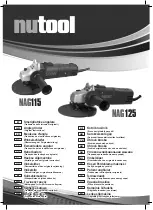
GB
6
Before Use
• Always check that all parts or attachments are secure, and that rotating
parts will not come in contact with the guards or machine case
• Be aware that the cast metal motor housing may get hot during use.
• Ensure that any ventilation holes are not obscured in any way. Hot
air may be emitted from the machine when in use
• Always wear suitable personal protective equipment while working with this tool. Use of
this machine requires ear defenders, safety goggles, gloves, and a breathing mask
• This tool is earthed and requires an earthed 3-pin socket
• This tool is not suitable for outdoor use
Fitting a grinding wheel
WARNING:
Always unplug the grinder from the mains supply before attempting to fit or replace
any attachment. Never fit any attachment with a maximum speed lower than the no load speed
of the machine.
• Only fit wheels of the correct size for this machine (see Specifications)
• Remove the screws in the end cover of the Wheel Guards (3), and remove the end cover
• Remove the retaining nut from the centre of the grinding wheel
• The grinding wheel can now be removed and replaced
• Ensure that the retaining nut and end cover are replaced and securely tightened before use
Note:
Over-tightening the retaining nut can cause the wheel to crack. Do not use excess force
Operating Instructions
Switching ON/OFF
Note:
Do not switch the machine ON/OFF when under load. Always allow the motor to reach
its full speed before applying load, and to stop completely before leaving unattended
• To start the machine, press the part of the ON/OFF Switch (5) marked 'I'
• To start the machine, press the part of the ON/OFF Switch (5) marked '0'
Note:
The duty cycle of the bench grinder is a maximum 30 minutes continuous
operation. After 30 minutes continuous operation the grinder will require 30
minutes to cool before reusing. The cooling time is the ideal time to clean up
and remove the large amount of dust created by the grinding process.
Grinding
• Do not push the workpiece into the grinding wheel as you grind causing the grinding wheel to
slow. Instead allow the grinding wheel to maintain full speed and apply very minimal pressure
• Do not use grinding wheels that are damaged or have worn
down more than 25% from their original size
• Always hold work against the Tool Rest (4), and grip with both hands. Position
yourself so you have a comfortable grip on the workpiece without being
excessively close to the grinder. It is critical your clothes have no loose strands of
material especially on your arms and close to your hands that could be caught
by the grinding wheel forcing your hand into the grinding mechanism
• Do not attempt to work on material that is too small to grip securely
• Always refer to wheel manufacturer’s literature before use. Check that
the wheel is suitable for the material that you intend to work
• Metal grinding may produce sparks. Ensure that you are properly protected,
and that any flammable materials are removed from the work area
• When grinding, the workpiece will quickly become hot. It may be necessary to quench
the work in water to prevent heat damage. The fine-grade grinding wheel will produce
less heat and may be safer to use for some materials that are easily heat damaged
• Some materials may contain trace amount of toxic materials. If you are unsure
of the composition of the workpiece, it is recommended to remove grinding
dust frequently and always wear suitable respiratory protection
• Metallic dust can damage other tools if allowed to accumulate
by vents and be drawn in when the tool is operated
• When grinding has finished for the session, remove dust and vacuum work area and tool
Maintenance
WARNING:
Always remove the plug from the mains power supply
before carrying out any maintenance/cleaning.
Cleaning
• Keep your machine clean at all times. Dirt and dust will cause internal parts to wear quickly,
shortening the machine’s service life. Clean the body of your machine with a soft brush, or
dry cloth. If available, use clean, dry, compressed air to blow through the ventilation holes
Note:
There are no user serviceable parts within the grinder body.
Disposal
Always adhere to national regulations when disposing of power tools
that are no longer functional and are not viable for repair.
• Do not dispose of power tools, or other waste electrical and
electronic equipment (WEEE), with household waste
• Contact your local waste disposal authority for information
on the correct way to dispose of power tools
Fault
Cause
Solution
Machine will
not start
Plug fuse
Replace fuse
Circuit breaker
Reset circuit breaker
Tool fault
Contact dealer or authorised
service centre
Excessive vibration
in use
Wheel out of balance
Dress wheels
Wheel loose
Turn off immediately and
re-tighten wheel fittings
Wheel damaged
Replace wheel
Troubleshooting
263524_Manual.indd 6
28/03/2017 14:17







































